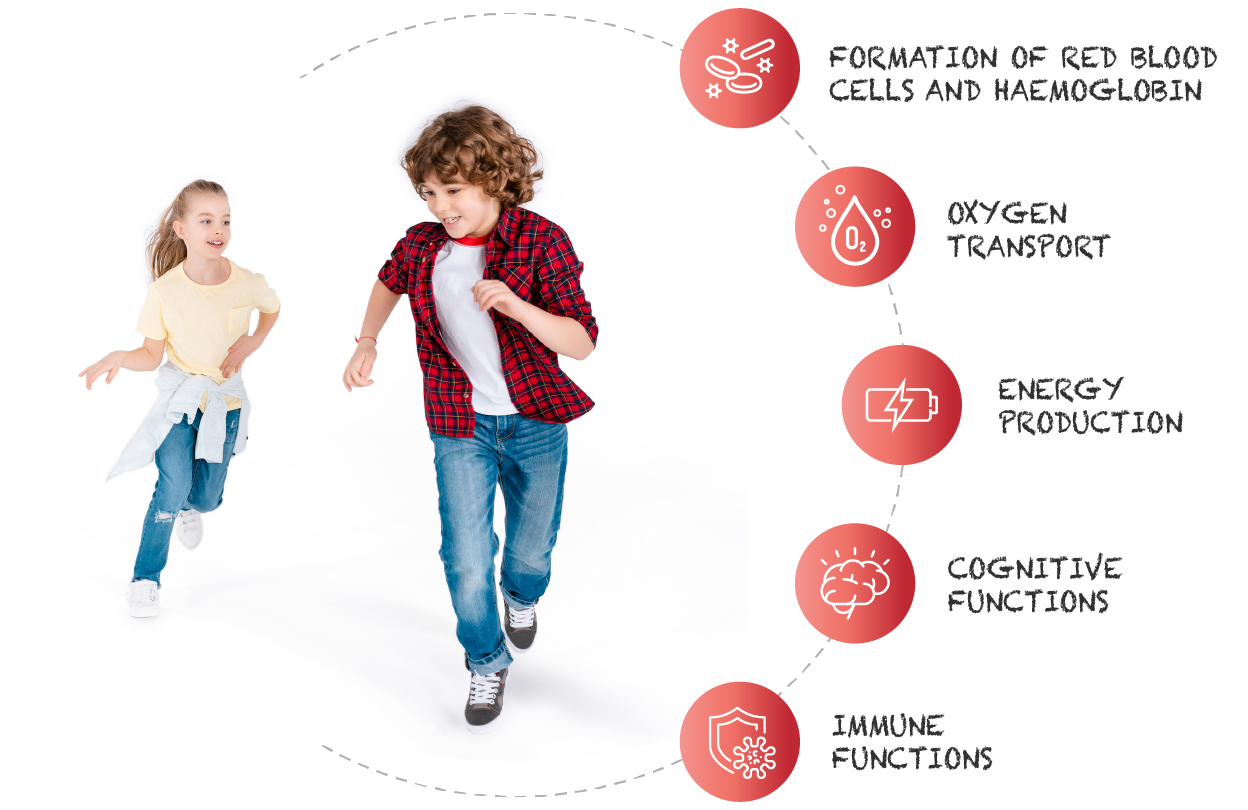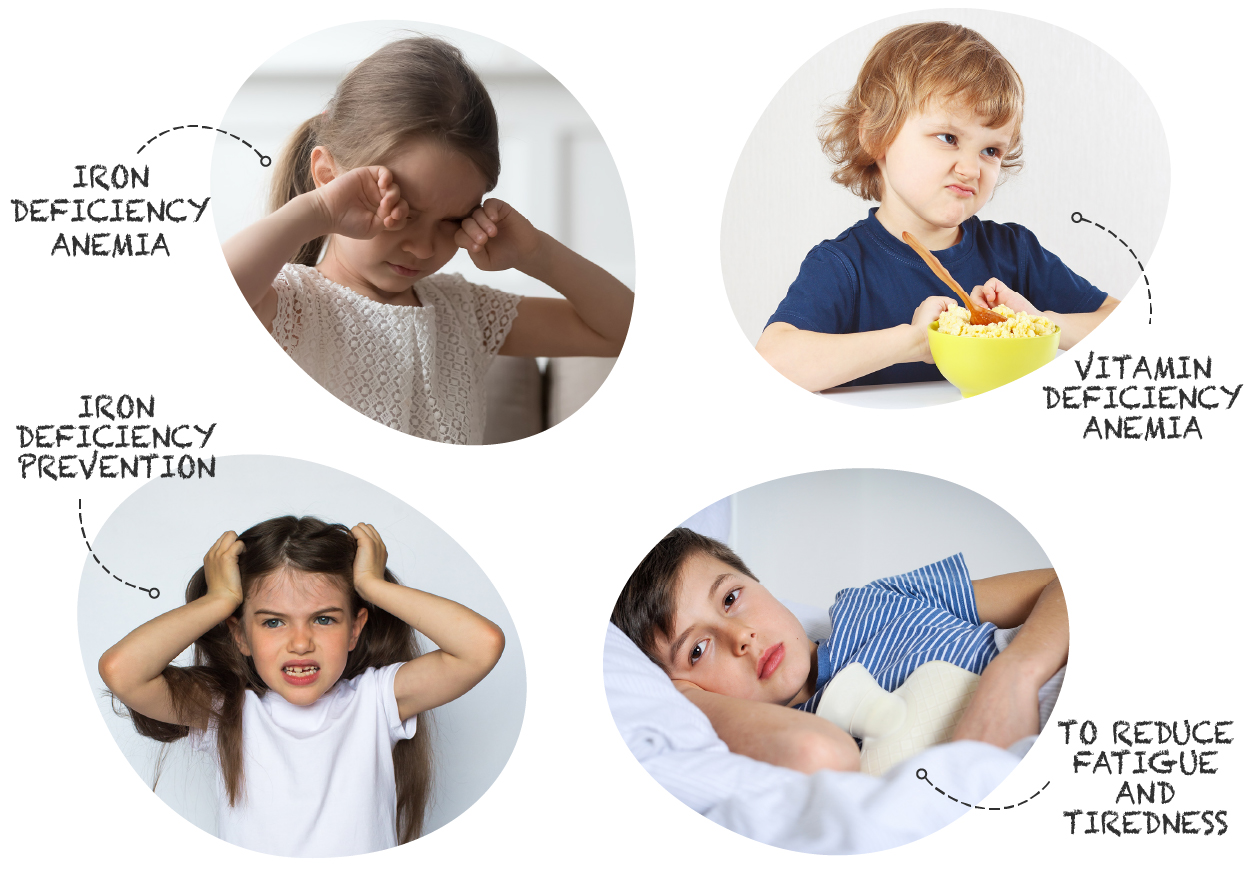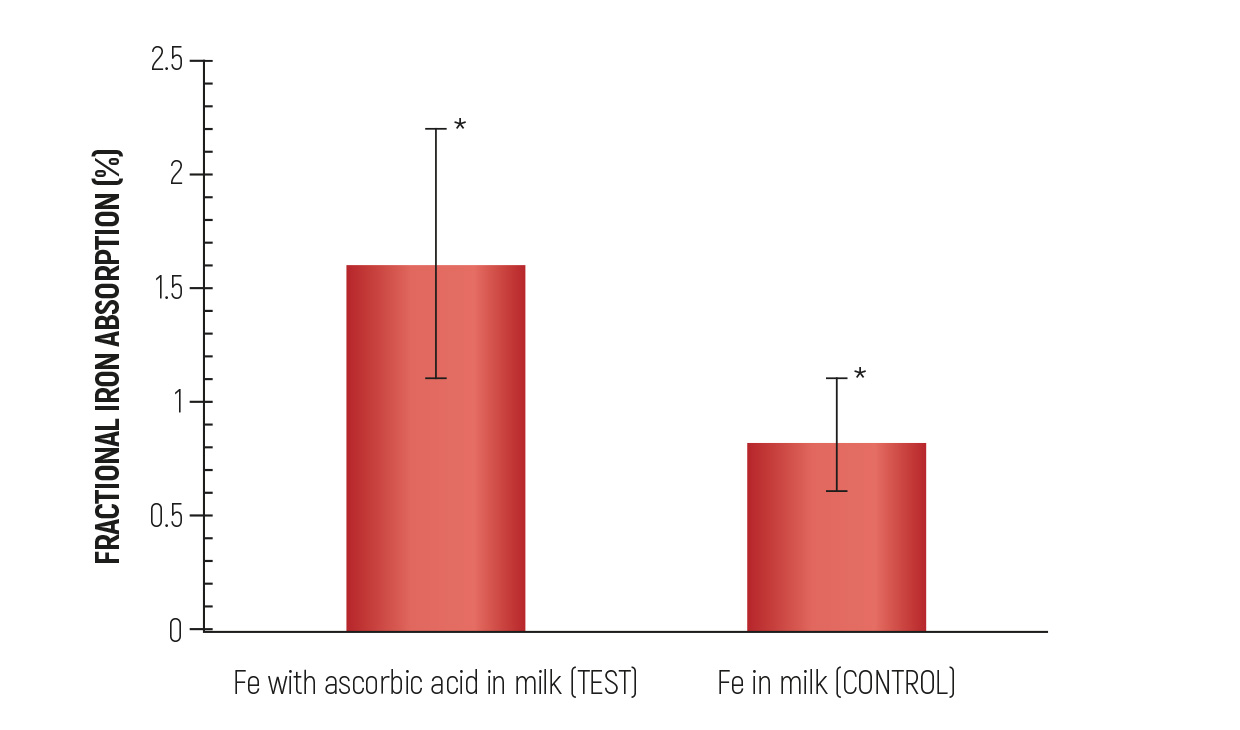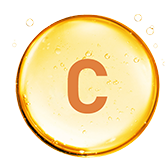
Restore your child’s iron reserves in a fast way!
Code:
4751018782179
Packaging:
28 Sachets


Iron is a vital nutrient for all humans, but especially crucial for kids. Infants and children are more prone to become iron deficient due to their rapid growth.
Iron is essential to the production of hemoglobin, a protein in red blood cells that shuttles oxygen to organs, muscles, tissues and cells, without sufficient iron intake, important parts of the children’s body will be affected.


Junio·Star® Ferrochelate contains amino acid chelated iron, that is is highly absorbable form of iron and gentler on the stomach than other iron forms.

Addressing low iron before iron deficiency anemia is diagnosed is important because some behavioural and developmental abnormalities may not be easily reversed, especially in infants and toddlers.




Usage: recommended for children from the age of 1 – 6 to use internally 1 sachet once per day after the meal, for children from the age of 7 – 12 – 1 sachet twice per day after the meal. Dilute the content of sachet in the glass of water or juice or meal in room temperature. Duration of usage up to 3 months.
Warnings: do not use food supplement as the substitute of balanced and valuable nutrition; do not exceed recommended daily dosage; high sensitivity (allergy) towards some of the product ingredients; keep out of reach and sight of children!
Store at room temperature in original packaging avoiding direct sunlight.

STUDY
The aim of the study was to compare iron absorption from ferrous sulfate, ferrous bisglycinate, and ferric 80 trisglycinate in whole-maize meal.
RESULTS
Study has shown absorption from chelated iron to be 4 times higher than other iron forms1.

Bovell-Benjamin, A C et al. “Iron absorption from ferrous bisglycinate and ferric trisglycinate in whole maize is regulated by iron status.” The American journal of clinical nutrition vol. 71,6 (2000): 1563-9.
STUDY
The aim of the study was to compare the efficacy of oral supplementation with ferrous bisglycinate and ferrous sulfate on ferritin concentration in schoolchildren with low iron stores1.
RESULTS
Study showed that group received bisglycinate chelate iron showed higher ferritin concentration in comparison to the group with ferrous sulfate supplementation and this positive effect of iron bisglycinate persisted 6 months after supplementation. Iron bisglycinate is highly absorbable iron form, than others and more gentle to the digestive system2.

Duque, X., Martinez, H., Vilchis-Gil, J. et al. Effect of supplementation with ferrous sulfate or iron bis-glycinate chelate on ferritin concentration in Mexican schoolchildren: a randomized controlled trial. Nutr J 13, 71 (2014).
STUDY
The aim of the study was to evaluate the effect of ascorbic acid on iron absorption and an ascorbic acid fortified milk beverage with respect to milk fortified with iron alone.
RESULTS
Study has shown that ascorbic acid with iron in milk * Fe with ascorbic acid in milk (TEST) as a fortificant enhanced iron absorption when compared to milk that is fortified with only iron2.

Pauline, Maria et al. “Effect of ascorbic acid rich, micro-nutrient fortified supplement on the iron bioavailability of ferric pyrophosphate from a milk based beverage in Indian school children.” Asia Pacific journal of clinical nutrition vol. 27,4 (2018): 792-796.
STUDY
Study was aimed to prove, that vitamin B6 deficiency affects iron concentration in tissues4.
RESULTS
Study shows, that vitamin B6 deficient group has no changes of iron concentration in tissues, but group with normal vitamin B6 consumption has greater effect of iron status, that proves vitamin B6 impact on the iron status of tissues in key metabolic tissues and hence needs to be factored into the amelioration of the condition.

Mackraj, Irene et al. “Vitamin B6 deficiency alters tissue iron concentrations in the Wistar rat.” Journal of trace elements in medicine and biology : organ of the Society for Minerals and Trace Elements (GMS) vol. 23,1 (2009): 43-9.Fishman, S et al. “The Role of Vitamins in the Prevention and Control of Anaemia.” Public Health Nutrition 3.2 (2000): 125-50. Print.
STUDY
The relationship between iron deficiency and vitamins B12 and B9 was recognized several decades ago. The aim of study was to examine the changes of vitamin B12/folate during treatment of iron deficiency anaemia5.
RESULTS
Study showed, that iron deficiency affect many metabolic pathways, including vitamin B12 and folate. These changes normalize after iron therapy.

Remacha, A F et al. “Vitamin B12 and folate levels increase during treatment of iron deficiency anaemia in young adult woman.” International journal of laboratory hematology vol. 37,5 (2015): 641-8. Fishman, S et al. “The Role of Vitamins in the Prevention and Control of Anaemia.” Public Health Nutrition 3.2 (2000): 125-50. Print.
National Organization for Medicines (EOF) of Greece (EOF Notification No.: 134182/30-11-2023),GMP
Usage: recommended for children from the age of 1 – 6 to use internally 1 sachet once per day after the meal, for children from the age of 7 – 12 – 1 sachet twice per day after the meal. Dilute the content of sachet in the glass of water or juice or meal in room temperature. Duration of usage up to 3 months.
Warnings: do not use food supplement as the substitute of balanced and valuable nutrition; do not exceed recommended daily dosage; high sensitivity (allergy) towards some of the product ingredients; keep out of reach and sight of children!
Store at room temperature in original packaging avoiding direct sunlight.

STUDY
The aim of the study was to compare iron absorption from ferrous sulfate, ferrous bisglycinate, and ferric 80 trisglycinate in whole-maize meal.
RESULTS
Study has shown absorption from chelated iron to be 4 times higher than other iron forms1.

Bovell-Benjamin, A C et al. “Iron absorption from ferrous bisglycinate and ferric trisglycinate in whole maize is regulated by iron status.” The American journal of clinical nutrition vol. 71,6 (2000): 1563-9.
STUDY
The aim of the study was to compare the efficacy of oral supplementation with ferrous bisglycinate and ferrous sulfate on ferritin concentration in schoolchildren with low iron stores1.
RESULTS
Study showed that group received bisglycinate chelate iron showed higher ferritin concentration in comparison to the group with ferrous sulfate supplementation and this positive effect of iron bisglycinate persisted 6 months after supplementation. Iron bisglycinate is highly absorbable iron form, than others and more gentle to the digestive system2.

Duque, X., Martinez, H., Vilchis-Gil, J. et al. Effect of supplementation with ferrous sulfate or iron bis-glycinate chelate on ferritin concentration in Mexican schoolchildren: a randomized controlled trial. Nutr J 13, 71 (2014).
STUDY
The aim of the study was to evaluate the effect of ascorbic acid on iron absorption and an ascorbic acid fortified milk beverage with respect to milk fortified with iron alone.
RESULTS
Study has shown that ascorbic acid with iron in milk * Fe with ascorbic acid in milk (TEST) as a fortificant enhanced iron absorption when compared to milk that is fortified with only iron2.

Pauline, Maria et al. “Effect of ascorbic acid rich, micro-nutrient fortified supplement on the iron bioavailability of ferric pyrophosphate from a milk based beverage in Indian school children.” Asia Pacific journal of clinical nutrition vol. 27,4 (2018): 792-796.
STUDY
Study was aimed to prove, that vitamin B6 deficiency affects iron concentration in tissues4.
RESULTS
Study shows, that vitamin B6 deficient group has no changes of iron concentration in tissues, but group with normal vitamin B6 consumption has greater effect of iron status, that proves vitamin B6 impact on the iron status of tissues in key metabolic tissues and hence needs to be factored into the amelioration of the condition.

Mackraj, Irene et al. “Vitamin B6 deficiency alters tissue iron concentrations in the Wistar rat.” Journal of trace elements in medicine and biology : organ of the Society for Minerals and Trace Elements (GMS) vol. 23,1 (2009): 43-9.Fishman, S et al. “The Role of Vitamins in the Prevention and Control of Anaemia.” Public Health Nutrition 3.2 (2000): 125-50. Print.
STUDY
The relationship between iron deficiency and vitamins B12 and B9 was recognized several decades ago. The aim of study was to examine the changes of vitamin B12/folate during treatment of iron deficiency anaemia5.
RESULTS
Study showed, that iron deficiency affect many metabolic pathways, including vitamin B12 and folate. These changes normalize after iron therapy.

Remacha, A F et al. “Vitamin B12 and folate levels increase during treatment of iron deficiency anaemia in young adult woman.” International journal of laboratory hematology vol. 37,5 (2015): 641-8. Fishman, S et al. “The Role of Vitamins in the Prevention and Control of Anaemia.” Public Health Nutrition 3.2 (2000): 125-50. Print.
National Organization for Medicines (EOF) of Greece (EOF Notification No.: 134182/30-11-2023),GMP

















